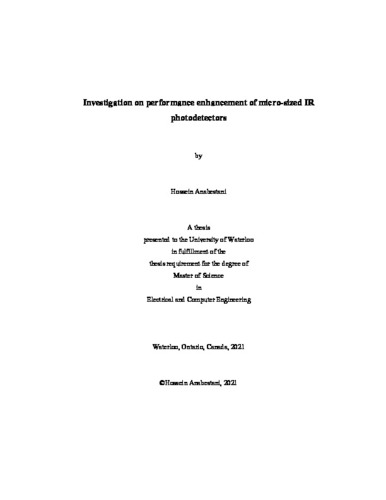| dc.description.abstract | As an Infrared detector with high responsivity, high transmission speed, and low dark current, InP/InGaAs p-i-n photodetectors (PD) have been used as a promising technology for many applications, including optical communication and various imaging applications, for over two decades.
In the following optoelectronic devices scaling down, such as micro-sized light-emitting diodes (LEDs), the integration of PDs in micro-sizes may find a more important position in the near future. Device size shrinkage would be essential to achieve a low dark current and a low depletion capacitance. However, the biggest technical challenge with the conventional micro-size p-i-n detector is producing a significant dark current due to surface recombination. The increased surface area to volume ratio leads to a high carrier surface recombination rate, which significantly degrades the performance of InP-InGaAs micro-sized PDs, including the responsivity and detectivity.
In this case, the most important parameter affecting device performance is the surface recombination velocity (SRV), reflecting the impact of surface recombination rate, depending majorly on the etching process and the passivation layer quality.
This thesis investigates the size-dependent properties of the micro-sized PDs, such as dark current, capacitance, and responsivity. In this work, the simulation tool Atlas SILVACO is employed to simulate the optoelectrical properties of the devices and Finite Difference Time Domain (FDTD) for the optical simulation.
The simulation results show that the responsivity of micro-sized PDs decreases from 80% to 15% when the size shrinks down from 100 μm to 10 μm. To suppress this performance degradation, we went through two different investigation routes.
First of all, we studied two different top surface configurations to couple more light into the micro-sized PDs. Both optical and optoelectrical simulations showed that the configuration with one-sided contact improves the generation rate, reflectivity, and responsivity by ~33%.
Secondly, we scrutinized the enhancement of the gating technique in the performance of the micro-sized PDs. By changing the surface potential and electron concentration at sidewalls, this technique helps to decrease the dark current density in reverse gate biases. The increment of this method for external quantum efficiency (EQE) was ~18%. | en |

